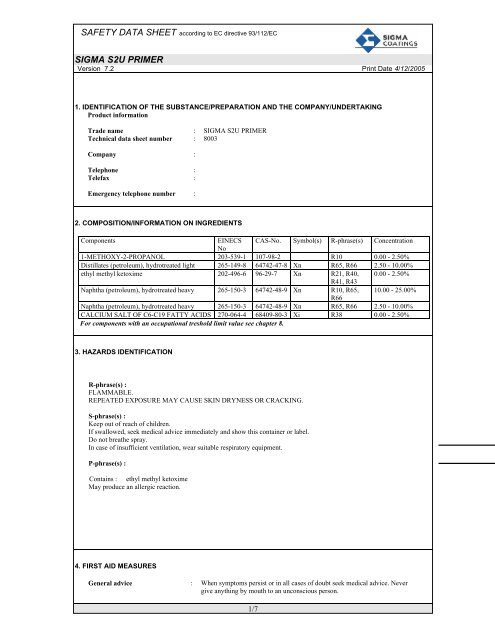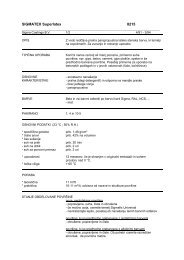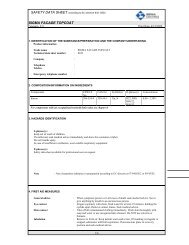SIGMA S2U PRIMER - Sigma Coatings
SIGMA S2U PRIMER - Sigma Coatings
SIGMA S2U PRIMER - Sigma Coatings
Create successful ePaper yourself
Turn your PDF publications into a flip-book with our unique Google optimized e-Paper software.
SAFETY DATA SHEET according to EC directive 93/112/EC<strong>SIGMA</strong> <strong>S2U</strong> <strong>PRIMER</strong>Version 7.2 Print Date 4/12/20051. IDENTIFICATION OF THE SUBSTANCE/PREPARATION AND THE COMPANY/UNDERTAKINGProduct informationTrade name : <strong>SIGMA</strong> <strong>S2U</strong> <strong>PRIMER</strong>Technical data sheet number : 8003Company :Telephone :Telefax :Emergency telephone number :2. COMPOSITION/INFORMATION ON INGREDIENTSComponentsEINECS CAS-No. Symbol(s) R-phrase(s) ConcentrationNo1-METHOXY-2-PROPANOL 203-539-1 107-98-2 R10 0.00 - 2.50%Distillates (petroleum), hydrotreated light 265-149-8 64742-47-8 Xn R65, R66 2.50 - 10.00%ethyl methyl ketoxime 202-496-6 96-29-7 Xn R21, R40, 0.00 - 2.50%R41, R43Naphtha (petroleum), hydrotreated heavy 265-150-3 64742-48-9 Xn R10, R65, 10.00 - 25.00%R66Naphtha (petroleum), hydrotreated heavy 265-150-3 64742-48-9 Xn R65, R66 2.50 - 10.00%CALCIUM SALT OF C6-C19 FATTY ACIDS 270-064-4 68409-80-3 Xi R38 0.00 - 2.50%For components with an occupational treshold limit value see chapter 8.3. HAZARDS IDENTIFICATIONR-phrase(s) :FLAMMABLE.REPEATED EXPOSURE MAY CAUSE SKIN DRYNESS OR CRACKING.S-phrase(s) :Keep out of reach of children.If swallowed, seek medical advice immediately and show this container or label.Do not breathe spray.In case of insufficient ventilation, wear suitable respiratory equipment.P-phrase(s) :Contains : ethyl methyl ketoximeMay produce an allergic reaction.4. FIRST AID MEASURESGeneral advice : When symptoms persist or in all cases of doubt seek medical advice. Nevergive anything by mouth to an unconscious person.1/7
SAFETY DATA SHEET according to EC directive 93/112/EC<strong>SIGMA</strong> <strong>S2U</strong> <strong>PRIMER</strong>Version 7.2 Print Date 4/12/2005Eye contact : Irrigate copiously with clean, fresh water for at least 10 minutes, holding theeyelids apart. Remove contact lenses. Seek medical advice.Skin contact : Take off all contaminated clothing immediately. Wash skin thoroughly withsoap and water or use recognized skin cleanser. Do NOT use solvents orthinners.Inhalation : Remove to fresh air. Keep patient warm and at rest. If breathing is irregular orstopped, administer artificial respiration. If unconscious place in recoveryposition and seek medical advice.Ingestion : If accidently swallowed obtain immediate medical attention. Keep at rest. Donot induce vomiting.5. FIRE-FIGHTING MEASURESSpecific hazards during firefighting: As the product contains combustible organic components, fire will producedense black smoke containing hazardous products of combustion (see section10). Exposure to decomposition products may be a hazard to health. Coolclosed containers exposed to fire with water spray. Do not allow run-off fromfire fighting to enter drains or water courses.: In the event of fire, wear self-contained breathing apparatus.Special protective equipmentfor fire-fightersSuitable extinguishing media : Use water spray, alcohol-resistant foam, dry chemical or carbon dioxide. Keepcontainers and surroundings cool with water spray.Extinguishing media which : Do NOT use water jet.must not be used for safetyreasons6. ACCIDENTAL RELEASE MEASURESPersonal precautions : Use personal protective equipment. Ventilate the area. Refer to protectivemeasures listed in sections 7 and 8. Wear respiratory protection. Beware ofvapours accumulating to form explosive concentrations. Vapours canaccumulate in low areas. Remove all sources of ignition.Environmental precautions : Try to prevent the material from entering drains or water ways. If the productcontaminates rivers and lakes or drains inform respective authorities.Methods for cleaning up : Clean with detergents. Avoid solvents. Contain and collect spillage withnon-combustible absorbent material, (e.g. sand, earth, diatomaceous earth,vermiculite) and place in container for disposal according to local / nationalregulations (see section 13).Additional advice : Refer to section 15 for specific national regulation.7. HANDLING AND STORAGEHandlingSafe handling advice : Avoid exceeding of the given occupational exposure limits (see section 8). Useonly in area provided with appropriate exhaust ventilation. Avoid contact withskin, eyes and clothing. Smoking, eating and drinking should be prohibited inthe application area. Avoid inhalation of vapour or mist. For personalprotection see section 8.2/7
SAFETY DATA SHEET according to EC directive 93/112/EC<strong>SIGMA</strong> <strong>S2U</strong> <strong>PRIMER</strong>Version 7.2 Print Date 4/12/2005Advice on protection againstfire and explosionStorage: Prevent the creation of flammable or explosive concentrations of vapour in airand avoid vapour concentration higher than the occupational exposure limits.When transferring from one container to another apply earthing measures anduse conductive hose material. No sparking tools should be used. The productshould only be used in areas from which all naked lights and other sources ofignition have been excluded. No smoking. The accumulation of contaminatedrags and dry overspray, particularly in spray booth filters, may result inspontaneous combustion. Good housekeeping standards, regular safe removalof waste materials and regular maintenance of spray booth filters willminimise the risks of spontaneous combustion and other fire hazards.Requirements for storage areasand containers: Observe label precautions. Prevent unauthorized access. Containers which areopened must be carefully resealed and kept upright to prevent leakage. Storebetween 5 and 25°C (41 - 77 F) in a dry, well ventilated place away fromsources of heat, ignition and direct sunlight. Solvent vapours are heavier thanair and may spread along floors. Vapours may form explosive mixtures withair. Electrical installations / working materials must comply with thetechnocological safety standards. Keep away from sources of ignition - Nosmoking. Store in accordance with the particular national regulations (seesection 15).Advice on common storage : Keep away from oxidising agents and strongly acid or alkaline materials.8. EXPOSURE CONTROLS / PERSONAL PROTECTIONMinimum ventilated air quantity for 1 liter of productTO REACH TLV : 316 m3/l Basis: MAC (NL)TO REACH 10 % LEL : 85 m3/lTLV of the product : 1,108 mg/m3 Basis: MAC (NL)Components with workplace control parametersComponents CAS-No. Value[mg/m 3 ]1-METHOXY-2-PROPANOL107-98-2 375.00can be absorbed through skin375.00568.00Value[ppm]100.00100.00150.00BasisMAC (NL) TWAEU ELV TWAEU ELV STELDistillates (petroleum), hydrotreated light 64742-47-8 1,200.00 ESIG TWANaphtha (petroleum), hydrotreated heavy 64742-48-9 1,200.00 ESIG TWANaphtha (petroleum), hydrotreated heavy 64742-48-9 1,200.00 ESIG TWAPersonal protective equipmentGeneral adviceRespiratory protection : When operators, whether spraying or not, have to work inside the spray booth,ventilation is unlikly to be sufficient to control particulates and solvent vapourin all cases. In such circumstances they should wear a compressed air-fedrespirator during the spraying process and until such time as the particulatesand solvent vapour concentration has fallen below the exposure limits.3/7
SAFETY DATA SHEET according to EC directive 93/112/EC<strong>SIGMA</strong> <strong>S2U</strong> <strong>PRIMER</strong>Version 7.2 Print Date 4/12/2005Hand protection : For prolonged or repeated contact use protective gloves. Barrier creams mayhelp to protect the exposed areas of skin, they should however not be appliedonce exposure has occurred. Skin should be washed after contact.Eye protection : Chemical resistant goggles must be worn.Skin and body protection : Personnel should wear protective clothing. Skin should be washed aftercontact. Working clothes must not consist of textiles, which show a dangerousmelting behaviour in case of fire. Workers should wear antistatic footwear.Additional advice :: <strong>Sigma</strong>Kalon Internal Safety Code (INSACO)Personal protection : Eye protection and safety glovesPlease contact your personal protection equipment supplier for further advice9. PHYSICAL AND CHEMICAL PROPERTIESForm : viscousColour : variousOdour : hydrocarbon-like very faintFlash point : 46.3 °CNote: CalculatedAutoignition temperature : > 210 °CLower explosion limit : 0.69 %(V)Density : 1.31 g/cm3at 20 °CWater solubility : immiscibleViscosity, dynamic : 1,000 mPa.s at 23 °CFlow time : >= 60 sTransversal section: 6 mmMethod: ISO 2431 (EN 535) 6 mm CUP10. STABILITY AND REACTIVITYConditions to avoid : Avoid temperatures above 60°C (140 F), direct sunlight and contact withsources of heat.Hazardous reactions : Keep away from oxidising agents, strongly alkaline and strongly acidmaterials in order to avoid exothermic reactions.Hazardous decompositionproducts: In case of fire hazardous decomposition products may be produced such as:Carbon dioxide (CO2), carbon monoxide (CO), oxides of nitrogen (NOx),dense black smoke.11. TOXICOLOGICAL INFORMATIONAcute oral toxicity : May cause nausea, abdominal spasms and irritation of the mucous membranes.4/7
SAFETY DATA SHEET according to EC directive 93/112/EC<strong>SIGMA</strong> <strong>S2U</strong> <strong>PRIMER</strong>Version 7.2 Print Date 4/12/2005Acute inhalation toxicity : Exposure to component solvent vapours concentration in excess of the statedoccupational exposure limit may result in adverse health effects. Such as:mucous membrane irritation, respiratory system irritation, adverse effects onkidney, liver and central nervous system. Symptoms and signs: headache,dizziness, fatigue, muscular weakness, drowsiness and in extreme cases loss ofconsciousness.Skin irritation : Repeated or prolonged contact with the preparation may cause removal ofnatural fat from the skin resulting in desiccation of the skin. The product maybe absorbed through the skin.Eye contact : The liquid splashed in the eyes may cause irritation and reversible damage.Further information : There is no data available for this product.12. ECOLOGICAL INFORMATIONFurther information : The preparation has been assessed following the conventional method of theDangerous Preparations Directive 1999/45/EC and is classified forecotoxicological properties accordingly. See sections 2 and 15 for details.13. DISPOSAL CONSIDERATIONSProduct : The product should not be allowed to enter drains, water courses or the soil.Disposal together with normal waste is not allowed. Special disposal requiredaccording to local regulations.14. TRANSPORT INFORMATIONTransport to be in accordance with ADR for road, IMDG for sea and IATA for air transport:UN-No : 1263Proper shipping name : PAINTClass : 3Packing group : IIILabel : 3Marine Pollutant (IMDG)(P,PP,-) : -EmS (IMDG) : F-E, S-ELimited quantity (ADR) : Max. per inner pack. : 5.00 LMax. per outer pack. : 45.00 LLimited quantity (IMDG) : Max. per inner pack. : 5.00 LMax. per outer pack. : 30.00 KGNoteIf pack sizes less than 450L, under the terms of 2.2.3.1.5, this product is not subject to the provisions of ADR.If pack sizes up to and including 30L, under the terms of 2.3.2.5, this product is not subject to the packaging, labelling andmarking requirements of the IMDG code, but both full documentation and placarding of cargo transport units is stillrequired.15. REGULATORY INFORMATIONRemarks : A hard copy of the label is placed in section 35/7
SAFETY DATA SHEET according to EC directive 93/112/EC<strong>SIGMA</strong> <strong>S2U</strong> <strong>PRIMER</strong>Version 7.2 Print Date 4/12/2005R-phrase(s) : R10 Flammable.R66Repeated exposure may cause skin dryness orcracking.S-phrase(s) : S 2 Keep out of reach of children.S46If swallowed, seek medical advice immediately andshow this container or label.S23Do not breathe spray.S38In case of insufficient ventilation, wear suitablerespiratory equipment.P-phrase(s) : P99 Contains :ethyl methyl ketoximeMay produce an allergic reaction.VOC : 361.5 g/lMethod: CalculatedNational legislationVlarem : P2CPR Classification : K3NER Classification : NER Class O.1: 0 %(m)NER Class O.2: 0 %(m)NER Class O.3: 27 %(m)16. OTHER INFORMATIONExplanation of R-phrases mentioned in section 21-METHOXY-2-PROPANOL R10 Flammable.Distillates (petroleum), hydrotreated light R65 Harmful: may cause lung damage if swallowed.R66 Repeated exposure may cause skin dryness or cracking.ethyl methyl ketoxime R21 Harmful in contact with skin.R40 Limited evidence of a carcinogenic effect.R41 Risk of serious damage to eyes.R43 May cause sensitization by skin contact.Naphtha (petroleum), hydrotreated heavy R10 Flammable.R65 Harmful: may cause lung damage if swallowed.R66 Repeated exposure may cause skin dryness or cracking.Naphtha (petroleum), hydrotreated heavy R65 Harmful: may cause lung damage if swallowed.R66 Repeated exposure may cause skin dryness or cracking.CALCIUM SALT OF C6-C19 FATTYACIDSR38Irritating to skin.6/7
SAFETY DATA SHEET according to EC directive 93/112/EC<strong>SIGMA</strong> <strong>S2U</strong> <strong>PRIMER</strong>Version 7.2 Print Date 4/12/2005Version: 7.2 Revision date 30.01.2004The information contained in this safety data sheet is based on the present state of knowledge and current nationallegislation at the date of issue. The company reserves the right to modify data without notice. Any change in data willnormally be followed by issue of a new safety data sheet. The user should check the date of issue and if more than 12months have elapsed, then the data should only be used after checking with our nearest sales office to establish that theyare still valid. . As the specific conditions of use of the product are outside the suppliers control, the user is responsible forensuring that the requirements of relevant legislation are complied with. None of the information contained in this safetydata sheet can be constructed as a guarantee with regard to the properties of the product described. No liability can beaccepted on the basis of this safety data sheet.After all component(s) stated on the relevant Technical Data Sheet have been mixed the safety precautions mentioned oneach of the component(s) safety data sheets and labels should be used in assessing the safety precautions of the mixedproduct.For further information see technical data sheet number: 80037/7









